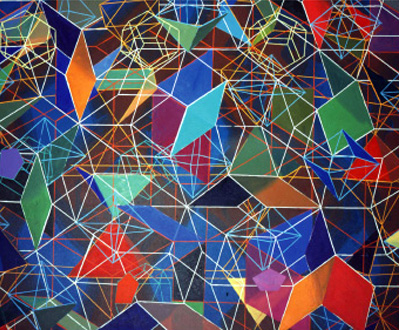Tony Robbin is a local American artist (a native of Washington D.C) who combines influences as wide-ranging as modern physics and the cubist movement. He has participated in over 100 group art shows, and has had over 25 solo exhibitions since debuting his artwork in 1974. Through his two dimensional digital drawings, Robbin attempts to create visual representations of four dimensional space. Robbin has also attempted to depict four-dimensional space through three dimensional sculpture, although he is best known his digital drawings. Robbin was actual a forerunner for the computer visualization of four-dimensional geometry, and holds the patent for "Quasicrystal" software, which he employs in many of his two and three dimensional works. He also lectures extensively on a variety of topics, including architecture, engineering, computer science, physics, mathematics, and art. Robbin has also published several books on his interdisciplinary approaches to mathematics, art, and digital technologies.
Robbin is considered a member of the only art movement of the post-modern era, known as pattern and decoration, or P&D. The movement was a contemporary reaction against Minimalism, and followed a "more is more" philosophy, focusing on highly saturated colors, complex patterns, and graphic images. While many other members of this movement employ more traditional media, such as painting and printmaking, Robbin's work integrates nicely with that of his contemporaries. Many other members of the P&D movement drew inspiration extensively from folk art, in particular, fabrics, in their artwork. Robbin's works reference and draw influences from similar backgrounds, including geometric Persian motifs, Japanese silk kimonos, and other textiles.
I find Robbin's works aesthetically pleasing and visually interesting; the line patterns and vast array of colors keep the viewer's eye moving, and the ornate compositions of geometric shapes are impressive. Robbin's pieces are also excellent examples of seamless integration of digital technology into art; the drawings have a painterly, hand drawn feel to them, which keeps the jagged angles and lines from feeling artificial and forced. However, though the concepts behind Robbin's works are fascinating, viewed as a whole, his body of art strikes me as somewhat repetitive. While Robbin has dabbled in sculpture, his three dimensional work is extremely similar in subject matter and composition to his drawings, and does not offer any more intriguing innovations. Considering his career as an artist spans over 40 years, his subject matter and methods of depiction remain quite static. I would be really interested to see any of Robbin's works in other medias, or even pieces with varying subject matter and compositions. Despite this, I think Robbin's works are for the most part very successful, and very engaging for the viewer. His balancing of color and detailed geometric figures is especially impressive.


No comments:
Post a Comment